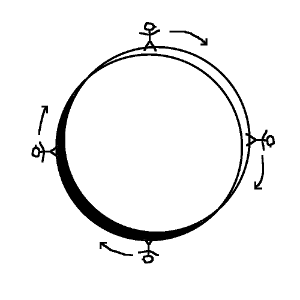I mentioned before that I love dungeons whose layout is a puzzle for the players to solve. This is one of them.
This dungeon is built along a single straight passageway. Rooms branch off from the passage, and you may have encounters in the tunnel itself. It’s important that the passage appears natural. The floor is uneven. You often have to clamber over natural steps or inconveniently-paced boulders. The ceiling rises and falls, and the walls pinch in and bow out in places. These interruptions in the PCs’ line of sight makes it harder for them to spot that the passage slopes downhill in both directions.
The passageway appears straight, but it’s actually a ring. If you’re in the passage, gravity always pulls towards the center of the ring, so you’re not aware that your feet aren’t pointed in the same direction they were ten minutes ago.

The deeper your PCs go into this dungeon, the closer they get to where they started. When they wind up back where they entered the dungeon, they should be suitably confused. They’ve been clambering down steps and boulders, so they know they’ve been going downhill. How can they be back at the beginning?
What of the rest of the dungeon? PCs should enter the ring at the ‘top’, perpendicular to the direction of the ring. From the party’s perspective, it’ll look like an ordinary ’T’ intersection. Rooms that branch off from the main passageway have the same gravitational direction as the spot where they meet the passage. You can, however, use the rooms to give some hints to the gravity shenanigans. If they’re natural, perhaps the perceived direction of gravity doesn’t match up with the appearance of the cave. Stalactites and stalagmites clearly formed when gravity was at a different angle from now, so they appear to be slanted at a 45 degree angle. If the rooms are constructed, perhaps the floor is heavily-slanted, and all the furniture all slid into the lowest corner.






